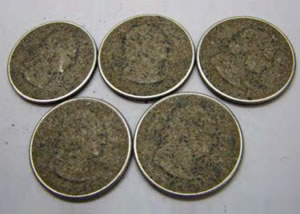Cleaning and Polishing Coins in a Rock Tumbler?

These coins are very corroded, but they can still be: 1) identified as current United States coins, and, 2) processed in coin-counting machines. As long as they meet those two requirements, most businesses will still accept them and they will still work in vending machines, toll booths and laundromats. Many banks will redeem them at face value and return them to the U.S. Mint for you. Ask your bank if they will accept them and save yourself the time and expense of cleaning coins. (Photo from USMint.gov)
How Should I Clean Coins?
Quite a few people write to us and ask how they should clean and polish coins in a rock tumbler.
We are sorry but we do not give advice on this topic.
Why? We believe that coins should not be cleaned in a rock tumbler because the tumbling will cause severe damage to the coins. We also believe that it is impossible to put a genuine "polish" on coins with a rock tumbler.
Words From the U.S. Mint
The United States Mint advises against cleaning coins, but they say... "If you absolutely must clean a coin to remove dirt, use good-quality mild soap and water."
The Mint has a special name for coins that are clearly recognizable but in poor condition. That name is "uncurrent coins". The Mint recommends contacting your bank to redeem these coins for full face value. Many banks will accept the coins and send them back to the Mint for recycling.
Giving the dirty coins to your bank is a lot faster, easier and cheaper than running them in your tumbler.
And, it's a good idea to listen to the U.S. Mint - because coins are government property in the United States (and most other countries).
Rock Tumblers Severely Damage Coins
If you go to YouTube you can find lots of videos that show people cleaning coins in rock tumblers. They dump in a few pounds of coins and a few pounds of sand or pea-size gravel and tumble away.
The particles of sand and gravel are much harder than the soft metals used to make coins. The result of the tumbling is to wear the edges off of the coins and rapidly destroy the coins' surfaces. These coins might have a "bright" finish when they come out of the tumbler, but if you look closely at their surface, you will see that it is deeply gouged from the abrasive treatment in the tumbler. The tumbling removed the dirt and a layer of metal from the coin!
But I Want Shiny Coins for My Collection!
You might decide to give your coins a "gentle cleaning" by tumbling them in a polish or in a soft media like crushed corn cob or walnut shell. If you do that your coins might come out with a brighter finish, but if you look closely, the edges of the coins will be damaged and their surfaces will be completely covered with scratches from the coins abrading against one another.
Experienced collectors will not want those scratched up coins.
Again, the U.S. Mint says that you should not do anything that will scratch the coin's surface. The Mint says.... "Believe it or not, older coins that show the deep coloration of age are far more desirable than coins whose surfaces have been stripped away by improper cleaning."
You can check out their "caring for coins" article on USMint.gov.
Mutilated Coins
If your coins are in worse shape than "uncurrent" then the Mint would consider them to be "mutilated". Mutilated coins are coins that are bent, not whole, melted together or severely corroded. The Mint is glad to redeem these for you if your bank is unable to help. You can get information on how to redeem mutilated coins from this document on the USMint.gov website.
Happy Tumbling!
We hope that you got an idea from this article for things to do instead of using your rock tumbler to process dirty coins into damaged coins. We would rather spend our time processing some nice tumbling rough and having some nice tumbled stones when we are finished!
RockTumbler.com Authors
 |
Hobart M. King has decades of rock tumbling experience and writes most of the articles on RockTumbler.com. He has a PhD in geology and is a GIA graduate gemologist. He also writes the articles about rocks, minerals and gems on Geology.com. |

